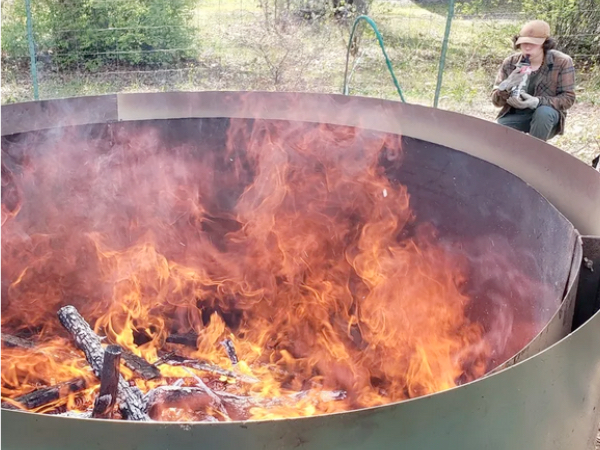As the planet heats up, so does interest in practical, affordable and scalable methods for drawing carbon out of the atmosphere. This helps explain the growing popularity of biochar, a “super charcoal” that improves soil, conserves water and sequesters carbon all at once.
This summer, Sonoma Ecology Center’s Sonoma Biochar Initiative (SBI) is taking local biochar production to a new level with portable kilns—a mobile biochar kit that can help foresters, farmers and others manage their surplus biomass better while drawing carbon out of the atmosphere.
“How do you make biochar cheaply in the forest? This is how,” says Raymond Baltar, director of the Sonoma Biochar Initiative, which has been studying and promoting biochar production and use for years. Raymond’s expertise on the subject has resulted in grant projects, speaking engagements and even an appearance in a Leonardo diCaprio film on climate change.
Now, thanks to a grant from the North Coast Resource Partnership, SEC will obtain five “ring of fire” kilns—metal kilns about seven feet in diameter, designed by Oregon-based Wilson Biochar Associates for the purpose of easily turning forest slash and other organic material into biochar on site. Sonoma Biochar Initiative, in partnership with Redwood Forest Foundation, Inc., will utilize the kilns in the Usal Redwood Forest, and the Potter Valley Tribe will use them on forested property recently acquired from PG&E, to process forest slash there that otherwise would simply be burned in open piles.
The kilns will also be used at an alternative biomass processing technique demonstration event in Scott Valley (Siskiyou County) being organized by the Scott River Watershed Council, who will also be demonstrating the Tigercat Carbonator 500. This large-scale air-curtain-style biomass processor, owned by Sonoma County Forester Dan Falk, can process 15 to 20 tons of woody biomass per hour while also producing large amounts of high-quality biochar.
“There’s a lot of interest in these kilns and other alternate methods for processing forest slash,” Raymond says. After the grant is completed the Sonoma Biochar Initiative plans to “continue getting them out into the community,” he adds, by bringing them to farms, vineyards, ranches and other places where organic material is processed. Production and use of biochar will be further integrated into Sonoma Ecology Center’s restoration efforts as well.
If slash is burned or left to rot on the forest floor, “much of that material would otherwise degrade into CO2 over time,” Raymond explains. “While leaving organic material in the forest to degrade naturally is critical for a healthy forest ecosystem and should always be done as part of sustainable forestry activities, there is often an overabundance of this material created during fuels reduction activities, and the typical solution for dealing with it is burning in open piles.”
But by producing biochar instead, “We can save up to 50 percent of the carbon in the plant material that otherwise would reenter the atmosphere, and put it to good use right back in the forest or in nearby agricultural activities.”
The full mobile biochar kit includes a trailer to haul the kilns and other equipment, plus a water trailer to douse the flames at the right time. It also includes tools, fire-safe clothing, propane tanks, and “everything you would need as a landowner or forestry operation.” Training in the assembly and safe use of the kilns is also included in the grant project.

